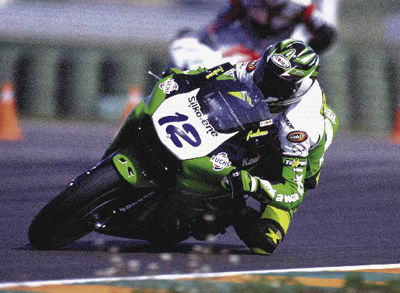Balzers Inc. usually applies one or two of 15 possible coatings to race car gears as well as various transmissions, cleans them and often applies pre- or post-treatments. One of the most popular pre-treatments is a proprietary enhancement of surface after mechanical or chemical microfinishing.
Torsten Doering, product manager at Balzers, says coating gears for better lubrication is essential to lower the coefficient of friction, increase efficiency and reduce wear, especially in racing applications.
“One of the most common modes of failure is fatigue. With coatings, it’s possible to apply higher loads, or you can run gears for longer periods of time before fatigue failure will occur,” he says. “A lower coefficient of friction and the run-in characteristics of our coatings improve gear performance. With dry conditions, the coefficient of friction of steel on steel is 0.7. Our coatings are consistently between 0.1 and 0.2. If there are lubricants in the mix, your coefficient is much lower.”
Reduced oil in transmissions is another issue that coating engineers have to deal with, says Doering. In order to meet the weight requirements dictated by every racing series, it’s commonplace to reduce the oil in transmissions. Since everything is moved through the oil, less oil means less resistance. Therefore, they need the coatings to provide enough lubrication.
Balzers’ newest series aims to toughen their coatings. The BALINIT Star carbon coatings have a chromium nitride layer underneath to distribute load better into substrate material. PVD coatings are much harder than the bulk material and very thin; point loads and softer substrates pose a challenge to this system. BALINIT Star coatings have a reliable supporting layer ensuring that the superposed carbon layer can have its proper effect, even on somewhat softer substrates such as those in the 40HRC range. This is meant to increase the load bearing capacity, allow for higher impact load and increase the operating reliability of components.
Jerry Hemmingson, owner of Jerico Racing Transmissions, has first-hand experience with what works in coatings as well as other tricks of the trade in racing transmissions, assembly and software. The 62-year-old had been racing cars his entire life and, around 1970, noticed a trend—the transmissions always broke. He started making transmissions for himself and today supplies to racing teams worldwide, including Joe Gibbs, Ralph James and most of the Winston Cup teams.
Jerico makes two-, three-, four-, five- and six-speed transmissions for numerous drag races with a heavy emphasis on stock, super stock, and elimination competitions. Hemmingson says that cars have been known to hit more than 400 mph in land speed with his transmissions and that, at one point, all the NASCAR teams used Jerico transmissions.
Early Trials Led to Modular Transmissions
“A lot of people have copied what we do. When we first started, our shifting mechanism was extremely forgiving and shifted like butter; it was so easy. We were one of the first to use straight cut gears when most everyone else was using stock transmission,” Hemmingson says. “We were also one of the first to make the whole transmission modular where it comes apart and you can change individual gear sets instead of being stuck with standard transmissions.”
Although Jerico does not manufacture the castings of cases or perform heat treating processes in-house, it does a lot within its 50,000-square-foot facility in Concord, NC. Any sawing, machining of gear blanks, broaching, cutting of gear blanks, shaft grinding after heat treating and machining of cases
and shifting mechanisms occurs at Jerico. Hemmingson says they’re the only company to manufacture everything right from raw material.
There’s a downside to this, he says, and that’s the increasing cost of obtaining the raw material. Hemmingson estimates a 500% increase in prices for raw materials since 2000, especially since the company only uses premium, vacuum arc remelt steel.
On the flip side, Hemmingson considers his supply of high quality equipment to be one of the secrets of his success. Jerico boasts seven CNC mills as well as 50 assorted CNC lathes, grinders and automated gear machines. The Studer S30 grinder is the pride and joy of the shop floor, promising tolerances within 1/10,000", which makes the tolerances more precise than for standard automotive applications. The Studer software uses gaging and probe touch-off, simplifying the profiling of the straight shafts that are commonplace at Jerico.
“It’s super accurate and reliable,” Hemmingson says. “It’s expensive, but I’d do anything to have two more.”
The business of racing cars isn’t easy to comprehend, Hemmingson acknowledges. “If you’re outside looking in, it probably looks like a very small number of customers or clients. But the number of customers, like the numbers of fans and enthusiasts in motorsports everywhere, continues to grow all over the world, and there’s racing going on in places where you never think of when you think of racing, like South Africa, Finland, the Netherlands, England. This may reflect a wide variety of types of racing, but it’s still racing and engineering, and the mechanics have to work. To be successful and stay ahead, you have to invest in the best technology and find the best people to run it.”
For more information:
EMCO Gears Inc.
4329 N. Kedzie
Chicago, IL 60618
Phone: (773) 539-1315
Fax: (773) 539-8792
Internet: www.emco-gears.com
Balzers Inc.
555 Commerce Dr.
Amherst, NY 14228
Phone: (716) 564-2788
Internet: www.balzers.com
Jerico Performance Products
A Division of Hemmingson Enterprises
443 Pitts School Rd. N.W.
Concord, NC 28027
Phone: (704) 782-4343
Fax: (704) 782-4443
Internet: www.jericoperformance.com
Photos are courtesy of Balzers Inc.
Comment on this article by sending e-mail to
publisher@geartechnology.com







